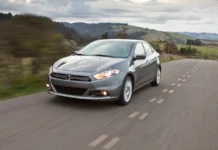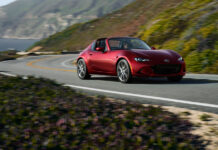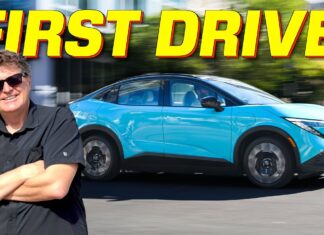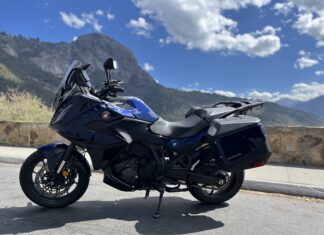
The 2013 Toyota Camry sedan looks sharper since its much-needed redesign for 2012. It retained its long-standing status as America’s top-selling car last year. Could 404,886 buyers be wrong? Maybe not, if all they wanted was a reliable, efficient car with a good quality reputation—although most models aren’t fun to drive—just an appliance.
| STATS | Starting Retail Price | As Tested Price | HP / Lb-Ft |
| 2013 Toyota Camry SE | $23,400 | $27,260 | 268/248 |
| EPA Rating MPG | As Tested MPG | ||
| Rating: BUY IT! | 21/31 | NA |
There are a variety of Camry models, including several gas/electric hybrids, to fit various budgets. List prices range from $22,235 for the base “L” four-cylinder model to $30,465 for the XLE V-6 version.
The 2012 front-wheel-drive Camry sedan got a widened, lower stance and upgraded interior. It also got a bit more-responsive handling, which isn’t saying much. But at least the SE V-6 sedan was—and is—rather fun to drive.
Toyota knew that a new rival Honda Accord, Nissan Altima, Mazda6 and Ford Fusion were coming for 2013 and wanted to get a jump on the competition. There’s no arguing with success, so the 2013 Toyota Camry has few changes. Some models have updated interior trim, and there’s new blind-spot monitor and rear cross-traffic alert options, which are handy in congested parking areas.
I tested the sporty $27,260 SE model with the Camry’s smooth, responsive 3.5-liter V-6, which is one of the best engines around. It helps make the SE a definite step above other Camrys when it comes to driving enjoyment. The SE V-6 has a sport suspension and 18-inch alloy wheel with low-profile 45-series tires. Its “sport-tuned” electric power steering is quick, although it feels dead, and the ride will probably be too firm for most typical Camry buyers—although it doesn’t beat you up.
The SE V-6’s handling is pretty good. The firm brake pedal controls disc brakes with a brake-assist feature and stops the car surely and quickly. The SE’s highlight is its potent 268-horsepower V-6, which makes 60-80 mph passing a breeze. The responsive six-speed automatic transmission has a manual shift feature, but hard-to-reach paddle shifters behind the steering wheel. You can manually select gears more easily with the console shifter, but the car was fine just left in the “drive” mode.
Other Camrys come with a 2.4-liter four-cylinder with 173-178 horsepower, which is the engine most order if only because the Camry is considerably less expensive with it. There’s also a Camry equipped with a hybrid power system, with 200 gas/electric horsepower combined.
Regular gas models have the six-speed automatic, while the hybrid uses a CVT automatic. Camrys deliver decent fuel economy, using regular-grade gasoline. My test SE model delivered an estimated 21 miles per gallon in the city and 31 on highways.The hybrid gets an estimated 43 mpg city and 39 highway, with the Camry four-cylinder ratings in the middle.
Visually distinguishing the SE are fog lamps with a sport-mesh grille, integrated front and rear underbody spoilers, side rocker panels and a discreet rear trunk spoiler. The low front end can be easily scraped, but the dual chrome-tipped exhaust tips would look good on a prize-winning 1950s hot rod.
Inside the quiet, spacious, upscale interior of my test SE V-6 was a keyless start button, easily read gauges and decent controls. It also had a supportive “sport” driver’s seat, two-tone upholstery with nice stitching, cruise control, tilt/telescopic wheel, split-folding rear seatbacks and the usual power accessories. But the “fasten-seat-belt” reminder is loud, relentless and annoying.
Front console cupholders were conveniently placed (rear ones are in the fold-down armrest). There’s a deep covered console bin in which to hide cell phones and such, and doors have storage pockets. Safety items included 10 air bags and side curtains.
Camry options easily raise the list price. They include an $895 Convenience package that contains such items as the backup camera. A $650 package has a audio/navigation feature with an easily read touch screen. The blind-spot monitor is $500. A $1,075 Leather Package contains heated power front seats. A power tilt/slide moonroof costs $915, and I bet lots of Toyota dealers will order it.
The trunk is commendably large and has a wide opening. Its lid uses hinges instead of hydraulic struts and has no interior pull-down indented area or strap to help close it to prevent getting hands dirty on outside sheet metal—a curious omission for a family car.
Rear seatbacks flip forward to enlarge the cargo area through a large opening from the trunk to the backseat area, but they’re too thick to sit flat.
The hood glides open on twin struts and has an interior lining for sound control. I suspect, though, that most Camry hoods are opened only at service departments.
On the TFLcar scale of:
– Buy it
– Lease it
– Rent it or
-Forget it
I recommend that you Buy It! The 2013 Toyota Camry stays with the tried and reliable formula for success.
Check out this fun TFLcar Mashup video of 2012 Toyta Camry and the Chevrolet Volt:
 Dan Jedlicka joined the Chicago Sun-Times in February 1968 as a business news reporter and was named auto editor later that year. He has reviewed more than 4,000 new vehicles for the Sun-Times–far more than any newspaper auto writer in the country. Jedlicka also reviewed vehicles for Microsoft Corp.’s MSN Autos Internet site from January, 1996, to June, 2008. For more of Dan’s thoughtful and insightful reviews please visit his web site HERE.
Dan Jedlicka joined the Chicago Sun-Times in February 1968 as a business news reporter and was named auto editor later that year. He has reviewed more than 4,000 new vehicles for the Sun-Times–far more than any newspaper auto writer in the country. Jedlicka also reviewed vehicles for Microsoft Corp.’s MSN Autos Internet site from January, 1996, to June, 2008. For more of Dan’s thoughtful and insightful reviews please visit his web site HERE.




























